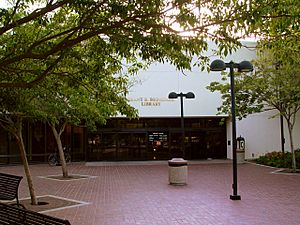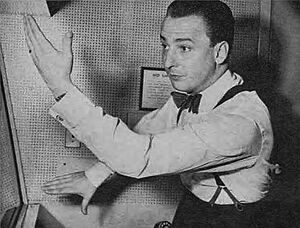American Radio Archives facts for kids
Quick facts for kids American Radio Archives |
|
|---|---|

American Radio Archives is located at the Grant R. Brimhall Library
|
|
| Lua error in Module:Infobox_mapframe at line 185: attempt to index field 'wikibase' (a nil value). | |
| 34°11′58.53″N 118°51′11.78″W / 34.1995917°N 118.8532722°W | |
| Location | 1401 E Janss Rd, Thousand Oaks, California, United States |
| Established | 1984 |
| Affiliation | Thousand Oaks Library |
The American Radio Archives is a special place inside the Thousand Oaks Library in Thousand Oaks, California. It holds one of the biggest collections of radio and TV history in the world! This amazing archive started in 1984. It was created by the Thousand Oaks Library Foundation.
Imagine finding 23,000 radio and TV scripts here! There are also 10,000 photos and 10,000 books about radio history. Plus, you can listen to 5,000 audio recordings. The archives keep old papers, sound recordings, and more. All these items help us learn about the history of radio and broadcasting.
The American Radio Archives is part of the Special Collections Department. This department is at the Grant R. Brimhall Library. The main goal of the archives is to gather, protect, and share materials. These materials tell the story of radio history forever. The Archives has been collecting items since the 1990s. They also have materials from the Pacific Pioneer Broadcasters. This group is made up of people who worked in radio. Adding their items made the collection much bigger.
The archives also include TV materials. This is because many actors and writers worked in both radio and television. So, the story of television is a big part of radio's history. The TV scripts here come from two main groups. There's a general Broadcasting Collection. There are also smaller collections. The Broadcasting Collection has scripts bought over many years. The smaller collections have materials put together by different people or groups. These scripts cover over 40 years of American TV history. This includes live shows from the 1940s through the 1980s. The archives have scripts for all kinds of TV shows. You can find soap operas, comedies, westerns, and crime series.
Discovering the Thousand Oaks Library
The Thousand Oaks Library system began in 1982. The American Radio Archives is a special part of this library. The library also has information about the early history of Conejo Valley. This includes old papers, stories from people, photos, and maps. Not all of the information is online yet. But the library is working to put more of its materials online. The American Radio Archives is located in the main library building.
Amazing Collections of Radio History
The American Radio Archives has one of the largest collections of radio broadcasting materials. It's one of the biggest in the United States and even the world! It holds 23,000 radio and TV scripts. There are also 10,000 photographs and 10,000 books about radio history. Plus, you can find 5,000 audio recordings.
Some very important collections are named after famous people. These include the Bob Crosby, Norman Corwin, Carlton E. Morse, Monty Masters, and Rudy Vallée collections. There's also a collection from KNX AM radio station. The Radio Series Scripts Collection has scripts from 1930 to 1990. The Radio Sound Records Collection has recordings from 1932 to 1994.
The collections include scripts, books, and personal papers. You can also find sound recordings, photos, and letters. All these items show the history of radio and TV broadcasting. Collections at the American Radio Archives are usually named after the person who gathered the materials. This is often the script writer. But it could also be a producer, an actor, or even a whole organization.
Exploring Specific Collections

You can find a full list of all the collections. Just visit the Thousand Oaks Library website. There are 44 collections listed there. Not all of them can be searched online. But more than half of them have online guides to help you. Here are some of the most interesting collections:
- Bob Crosby Collection: This collection has three books of scripts. They are from Jack Benny Show. Bob Crosby was the bandleader on this show from 1952 to 1955.
- Broadcasting Collection: This is the main collection of the archives. It has scripts that were donated or bought. These scripts are not part of any single person's collection. It includes many different show titles.
- Carlton E. Morse Collection: Carlton E. Morse wrote many radio shows. He also adapted his long-running series One Man's Family for television. This collection has scripts, photos, and letters. It also has other items about Morse's radio and TV work.
- LACC Collection: This collection has television scripts. They were given to the archives by the Los Angeles City College (LACC) Communications Department.
- Monty Masters Collection: This collection includes story ideas and scripts. It shows the work of Monty Masters. He was a comedian from San Francisco.
- Norman Corwin Collection: This collection has movie scripts and sound recordings. It also has scrapbooks, letters, and other items. These mostly relate to Norman Corwin's radio career. It includes his work for CBS like V-E day and On a Note of Triumph from 1945. His TV work includes Norman Corwin Presents. This collection is very large. It covers his career from 1935 to 1990.
- Rudy Vallée Collection: This collection has scrapbooks, letters, and scripts. They are about singer and songwriter Rudy Vallée. He was also an author, actor, and bandleader. This collection mostly shows shows where Vallée was a guest. It is a very big collection. It includes many of his personal papers. These documents cover his career from 1925 to 1975.

